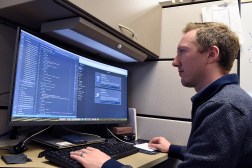Air Force launches new experimental chatbot powered by GenAI

As it continues to explore how to best leverage artificial intelligence, the Department of the Air Force is introducing a new platform for users to test a generative AI chatbot on unclassified networks.
Launched by the Air Force chief information officer and the Air Force Research Laboratory on Monday, the so-called NIPRGPT platform will allow airmen, guardians, civilian employees and contractors to interact with a chatbot on the Non-classified Internet Protocol Router Network (NIPRNet).
The GenAI-powered platform is not a final product for users, but rather a way for the department to experiment with generative AI tech in real-world scenarios as it continues to explore the capability’s potential, according to a press release.
“Technology is learned by doing,” Chandra Donelson, the DAF’s acting chief data and artificial intelligence officer, said in a statement. “As our warfighters, who are closest to the problems, are learning the technology, we are leveraging their insight to inform future policy, acquisition and investment solutions.”
According to the department, users can have human-like conversations with NIPRGPT in order to ask queries and receive assistance on various tasks, including correspondence, background papers and code. The platform is freely available to users with a Department of Defense Common Access Card, and interactions between the chatbot and human users occur in a secure environment.
As an experimental platform, the Air Force plans to focus on various key metrics of NIPRGPT’s performance — including “computational efficiency, resource utilization, security compliance” and more — in order to gauge generative AI’s “practical applications and challenges and ensure that future implementation is effective and efficient,” a DAF news release stated.
The department is encouraging users to provide feedback on NIPRGPT to help inform potential future integration of the technology. The platform will function as a “critical bridge” as the department works with the commercial sector to deploy the capabilities while navigating “intense security parameters and other processes,” Air Force Research Lab CIO Alexis Bonnel said.
“Changing how we interact with unstructured knowledge is not instant perfection; we each must learn to use the tools, query, and get the best results,” Bonnell said in a statement. “NIPRGPT will allow Airmen and Guardians to explore and build skills and familiarity as more powerful tools become available.”
NPIRGPT is also part of AFRL’s Dark Saber software platform — a software engineering ecosystem of airmen and guardians equipped with the tools needed to develop and deploy next-generation software and operational capabilities.
Organizations across the Defense Department have been exploring how generative AI could be used to assist the military in both day-to-day and tactical operations. The technology is a subfield of artificial intelligence that uses large language models to generate content based on prompts and data they are trained on.
In 2023, the Pentagon set up Task Force Lima to assess and synchronize generative AI exploration and adoption across the department. Some large language models have been deployed for use in limited environments at DOD, such as Microsoft’s GPT-4. The Navy also launched its own AI-powered chatbot last summer, although the platform is not powered by large language models.
Meanwhile, the Department of the Air Force recently wrapped up a series of roundtables with industry and academia to explore how and where generative AI can be used for its operations. CIO Venice Goodwine said in a statement that the roundtables demonstrated that generative AI is actively growing.
“Now is the time to give our Airmen and Guardians the flexibility to develop the necessary skills in parallel,” Goodwine said. “There are multiple modernization efforts going on right now across the federal government and within the DAF to get tools in the hands of the workforce. This tool is another one of those efforts.”






